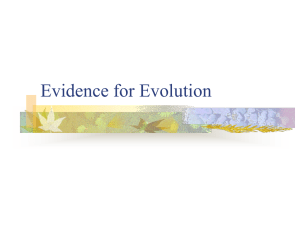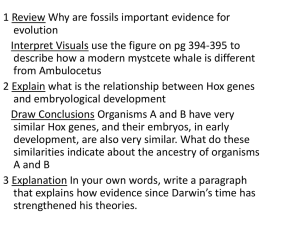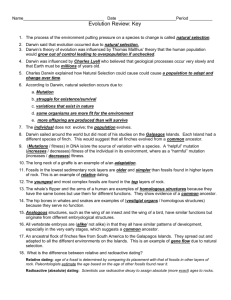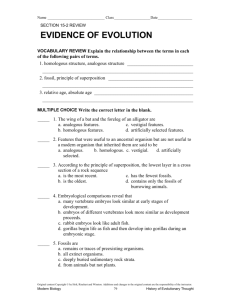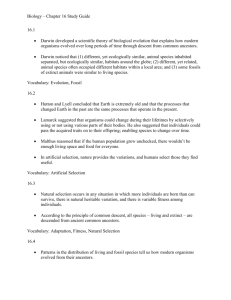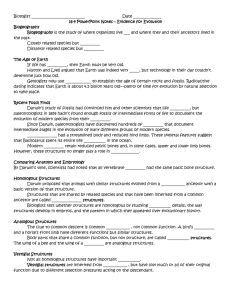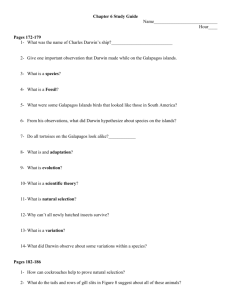Lesson Overview Evidence of Evolution 16.4 Evidence of Evolution
advertisement
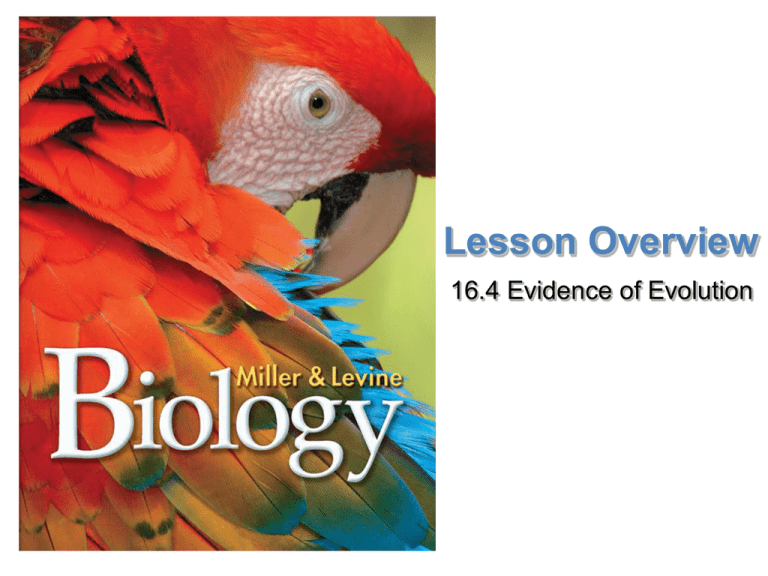
Lesson Overview Evidence of Evolution Lesson Overview 16.4 Evidence of Evolution Lesson Overview Evidence of Evolution THINK ABOUT IT Scientists in some fields, including geology, physics, paleontology, chemistry, and embryology, did not have the technology or understanding to test Darwin’s assumptions during his lifetime. And other fields, like genetics and molecular biology, didn’t exist yet! In the 150 years since Darwin published On the Origin of Species, discoveries in all these fields have served as independent tests that have supported Darwin’s basic ideas about evolution. Lesson Overview Evidence of Evolution Biogeography How does the geographic distribution of species today relate to their evolutionary history? Lesson Overview Evidence of Evolution Biogeography How does the geographic distribution of species today relate to their evolutionary history? Patterns in the distribution of living and fossil species tell us how modern organisms evolved from their ancestors. Lesson Overview Evidence of Evolution Biogeography Biogeography is the study of where organisms live now and where they and their ancestors lived in the past. Two biogeographical patterns are significant to Darwin’s theory. The first is a pattern in which closely related species differentiate in slightly different climates. The second is a pattern in which very distantly related species develop similarities in similar environments. Lesson Overview Evidence of Evolution Closely Related but Different To Darwin, the biogeography of Galápagos species suggested that populations on the island had evolved from mainland species. Over time, natural selection on the islands produced variations among populations that resulted in different, but closely related, island species. For example, natural selection produced variation in shell shape among the giant land tortoises that inhabit the islands. Lesson Overview Evidence of Evolution Distantly Related but Similar On the other hand, similar habitats around the world are often home to animals and plants that are only distantly related. Darwin noted that similar ground-dwelling birds (rheas, ostriches, and emus) inhabit similar grasslands in Europe, Australia, and Africa. Differences in body structures among those animals provide evidence that they evolved from different ancestors. Similarities among those animals, however, provide evidence that similar selection pressures had caused distantly-related species to develop similar adaptations. Lesson Overview Evidence of Evolution The Age of Earth and Fossils How do fossils help to document the descent of modern species from ancient ancestors? Lesson Overview Evidence of Evolution The Age of Earth and Fossils How do fossils help to document the descent of modern species from ancient ancestors? Many recently discovered fossils form series that trace the evolution of modern species from extinct ancestors. Lesson Overview Evidence of Evolution The Age of Earth Evolution takes a long time. If life has evolved, then Earth must be very old. Hutton and Lyell argued that Earth was indeed very old, but technology in their day couldn’t determine just how old. Geologists now use radioactivity to establish the age of certain rocks and fossils. Radioactive dating indicates that Earth is about 4.5 billion years old—plenty of time for evolution by natural selection to take place. Lesson Overview Evidence of Evolution Recent Fossil Finds Darwin’s study of fossils had convinced him and other scientists that life evolved, but paleontologists in 1859 hadn’t found enough fossils of intermediate forms of life to document the evolution of modern species from their ancestors. Since Darwin, paleontologists have discovered hundreds of fossils that document intermediate stages in the evolution of many different groups of modern species. Lesson Overview Evidence of Evolution Recent Fossil Finds One recently discovered fossil series documents the evolution of whales from ancient land mammals. Several reconstructions based on fossil evidence are shown on the following slides. The exceptions to the reconstructions are the modern Mysticete and Odontocete. Lesson Overview Evidence of Evolution Recent Fossil Finds Lesson Overview Evidence of Evolution Recent Fossil Finds The limb structure of Ambulocetus (“walking whale”) suggests that these animals could both swim in shallow water and walk on land. Lesson Overview Evidence of Evolution Recent Fossil Finds The hind limbs of Rodhocetus were short and probably not able to bear much weight. Paleontologists think that these animals spent most of their time in the water. Lesson Overview Evidence of Evolution Recent Fossil Finds Basilosarus had a streamlined body and reduced hind limbs. These skeletal features suggest that Basilosarus spent its entire life swimming in the ocean. Lesson Overview Evidence of Evolution Recent Fossil Finds Modern whales retain reduced pelvic bones and, in some cases, upper and lower limb bones. However, these structures no longer play a role in locomotion. Lesson Overview Evidence of Evolution Recent Fossil Finds Other recent fossil finds connect the dots between dinosaurs and birds, and between fish and four-legged land animals. All historical records are incomplete, and the history of life is no exception. The evidence we do have, however, tells an unmistakable story of evolutionary change. Lesson Overview Evidence of Evolution Comparing Anatomy and Embryology What do homologous structures and similarities in embryonic development suggest about the process of evolutionary change? Lesson Overview Evidence of Evolution Comparing Anatomy and Embryology What do homologous structures and similarities in embryonic development suggest about the process of evolutionary change? Evolutionary theory explains the existence of homologous structures adapted to different purposes as the result of descent with modification from a common ancestor. Lesson Overview Evidence of Evolution Comparing Anatomy and Embryology By Darwin’s time, scientists had noted that all vertebrate limbs had the same basic bone structure. Lesson Overview Evidence of Evolution Comparing Anatomy and Embryology For example, the front limbs of amphibians, reptiles, birds, and mammals contain the same basic bones. Lesson Overview Evidence of Evolution Homologous Structures Darwin proposed that animals with similar structures evolved from a common ancestor with a basic version of that structure. Structures that are shared by related species and that have been inherited from a common ancestor are called homologous structures. Biologists test whether structures are homologous by studying anatomical details, the way structures develop in embryos, and the pattern in which they appeared over evolutionary history. Lesson Overview Evidence of Evolution Homologous Structures Homologous bones, as shown by color-coding, support the differentlyshaped front limbs of modern vertebrates. Lesson Overview Evidence of Evolution Homologous Structures These limbs evolved, with modifications, from the front limbs of a common ancestor whose bones resembled those of an ancient fish. Similarities and differences among homologous structures help determine how recently species shared a common ancestor. For example, the front limbs of reptiles and birds are more similar to each other than either is to the front limb of an amphibian or mammal. This similarity—among many others—indicates that the common ancestor of reptiles and birds lived more recently than the common ancestor of reptiles, birds, and mammals. Lesson Overview Evidence of Evolution Homologous Structures Biologists have identified homologies in many other organisms. Certain groups of plants, for example, share homologous stems, roots, and flowers. Lesson Overview Evidence of Evolution Analogous Structures The clue to common descent is common structure, not common function. A bird’s wing and a horse’s front limb have different functions but similar structures. Body parts that share a common function, but not structure, are called analogous structures. The wing of a bee and the wing of a bird are analogous structures. Lesson Overview Evidence of Evolution Vestigial Structures Not all homologous structures have important functions. Vestigial structures are inherited from ancestors, but have lost much or all of their original function due to different selection pressures acting on the descendant. The hipbones of bottlenose dolphins are vestigial structures. In their ancestors, hipbones played a role in terrestrial locomotion. However, as the dolphin lineage adapted to life at sea, this function was lost. Lesson Overview Evidence of Evolution Vestigial Structures The wings of a flightless cormorant and the legs of an Italian three-toed skink are vestigial structures. Lesson Overview Evidence of Evolution Vestigial Structures Why would an organism possess structures with little or no function? One possibility is that the presence of a vestigial structure does not affect an organism’s fitness. In that case, natural selection would not eliminate it. Lesson Overview Evidence of Evolution Embryology Researchers noticed a long time ago that the early developmental stages of many animals with backbones (called vertebrates) look very similar. Recent observations make clear that the same groups of embryonic cells develop in the same order and in similar patterns to produce many homologous tissues and organs in vertebrates. Similar patterns of embryological development provide further evidence that organisms have descended from a common ancestor. Lesson Overview Evidence of Evolution Embryology Evolutionary theory offers the most logical explanation for these similarities in patterns of development. Similar patterns of embryological development provide further evidence that organisms have descended from a common ancestor. Lesson Overview Evidence of Evolution Genetics and Molecular Biology How can molecular biology be used to trace the process of evolution? Lesson Overview Evidence of Evolution Genetics and Molecular Biology How can molecular biology be used to trace the process of evolution? At the molecular level, the universal genetic code and homologous molecules provide evidence of common descent. Lesson Overview Evidence of Evolution Genetics and Molecular Biology Darwin had no idea how heredity worked, and he was worried that this lack of knowledge might prove fatal to his theory. As it happens, some of the strongest evidence supporting evolutionary theory comes from genetics. A long series of discoveries, from Mendel to Watson and Crick to genomics, helps explain how evolution works. Also, we now understand how mutation and the reshuffling of genes during sexual reproduction produce the heritable variation on which natural selection operates. Lesson Overview Evidence of Evolution Life’s Common Genetic Code All living cells use information coded in DNA and RNA to carry information from one generation to the next and to direct protein synthesis. Lesson Overview Evidence of Evolution Life’s Common Genetic Code This genetic code is nearly identical in almost all organisms, including bacteria, yeasts, plants, fungi, and animals. Lesson Overview Evidence of Evolution Life’s Common Genetic Code This compares a small portion of the DNA for the same gene in three animals—a mouse, a whale, and a chicken. Lesson Overview Evidence of Evolution Life’s Common Genetic Code This similarity in genetic code is powerful evidence that all organisms evolved from common ancestors. Lesson Overview Evidence of Evolution Homologous Molecules In Darwin’s day, biologists could only study similarities and differences in structures they could see. But physical body structures can’t be used to compare mice with yeasts or bacteria. Today, we know that homology is not limited to physical structures. Homologous proteins share extensive structural and chemical similarities. One homologous protein is cytochrome c, which functions in cellular respiration. Remarkably similar versions of cytochrome c are found in almost all living cells, from cells in baker’s yeast to cells in humans. Lesson Overview Evidence of Evolution Homologous Molecules Genes can be homologous, too. One example is a set of genes that determine the identities of body parts. Know as Hox genes, they help to determine the head to tail axis in embryonic development. In vertebrates, sets of homologous Hox genes direct the growth of front and hind limbs. Small changes in these genes can produce dramatic changes in the structures they control. Lesson Overview Evidence of Evolution Homologous Molecules Relatively minor changes in an organism’s genome can produce major changes in an organism’s structure and the structure of its descendants. At least some homologous Hox genes are found in almost all multicellular animals, from fruit flies to humans. For example, bacteria that live in a hot spring are very different from animals, yet many of their genes, and therefore the proteins coded by those genes, are similar to those of animals. Such profound biochemical similarities are best explained by Darwin’s conclusion: Living organisms evolved through descent with modification from a common ancestor. Lesson Overview Evidence of Evolution Testing Natural Selection What does recent research on the Galápagos finches show about natural selection? Lesson Overview Evidence of Evolution Testing Natural Selection What does recent research on the Galápagos finches show about natural selection? The Grants have documented that natural selection takes place in wild finch populations frequently, and sometimes rapidly. The Grants’ work shows that variation within a species increases the likelihood of the species’ adapting to and surviving environmental change. Lesson Overview Evidence of Evolution Testing Natural Selection One way to gather evidence for evolutionary change is to observe natural selection in action. One of the best examples of natural selection in action comes from observations of animals living in their natural environment—the Galápagos finches. Lesson Overview Evidence of Evolution A Testable Hypothesis Darwin hypothesized that the Galápagos finches he observed had descended from a common ancestor. He noted that several finch species have beaks of very different sizes and shapes. Each species uses its beak like a specialized tool to pick up and handle its food. Different types of foods are most easily handled with beaks of different sizes and shapes. Darwin proposed that natural selection had shaped the beaks of different bird populations as they became adapted to eat different foods. No one thought there was a way to test this hypothesis until Peter and Rosemary Grant of Princeton University came along. Lesson Overview Evidence of Evolution A Testable Hypothesis Lesson Overview Evidence of Evolution A Testable Hypothesis The Grants realized that Darwin’s hypothesis rested on two testable assumptions. First, for beak size and shape to evolve, there must be enough heritable variation in those traits to provide raw material for natural selection. Second, differences in beak size and shape must produce differences in fitness. Lesson Overview Evidence of Evolution A Testable Hypothesis The Grants have tested these hypotheses on the medium ground finch (Geospiza) on the island of Daphne Major. This island is large enough to support good-sized finch populations, yet small enough to allow the Grants to catch, tag, and identify nearly every bird of the species. Lesson Overview Evidence of Evolution A Testable Hypothesis During their study, the Grants periodically recapture the birds. They record which individuals are alive and which have died, which have reproduced and which have not. For each individual, the Grants record anatomical characteristics like wing length, leg length, beak length, beak depth, beak color, feather color, and total mass. Lesson Overview Evidence of Evolution Natural Selection The Grants’ data have shown that individual finches with different-size beaks have better or worse chances of surviving both seasonal droughts and longer dry spells. When food becomes scarce during dry periods, birds with the largest beaks are more likely to survive. As a result, average beak size in this finch population has increased dramatically. Lesson Overview Evidence of Evolution Natural Selection Changes in food supply created selection pressure that caused finch populations to evolve within decades. This evolutionary change occurred much faster than many researchers thought possible. The Grants have documented that natural selection takes place in wild finch populations frequently, and sometimes rapidly. Lesson Overview Evidence of Evolution Natural Selection The Grants’ data also confirm that competition and environmental change drive natural selection. Traits that don’t matter much under one set of environmental conditions became adaptive as the environment changes during a drought. Without heritable variation in beak sizes, the medium ground finch would not be able to adapt to feeding on larger, tougher seeds during a drought. The Grants’ work shows that variation within a species increases the likelihood of the species’ adapting to and surviving environmental change. Lesson Overview Evidence of Evolution Evaluating Evolutionary Theory Today, evolutionary theory—which includes natural selection—offers insights that are vital to all branches of biology, from research on infectious disease to ecology. That’s why evolution is often called the grand unifying theory of the life sciences. Lesson Overview Evidence of Evolution Evaluating Evolutionary Theory Like any scientific theory, evolutionary theory is constantly reviewed as new data are gathered. Researchers still debate important questions, such as precisely how new species arise and why species become extinct. There is also significant uncertainty about exactly how life began. However, any questions that remain are about how evolution works— not whether evolution occurs. To scientists, evolution is the key to understanding the natural world.
